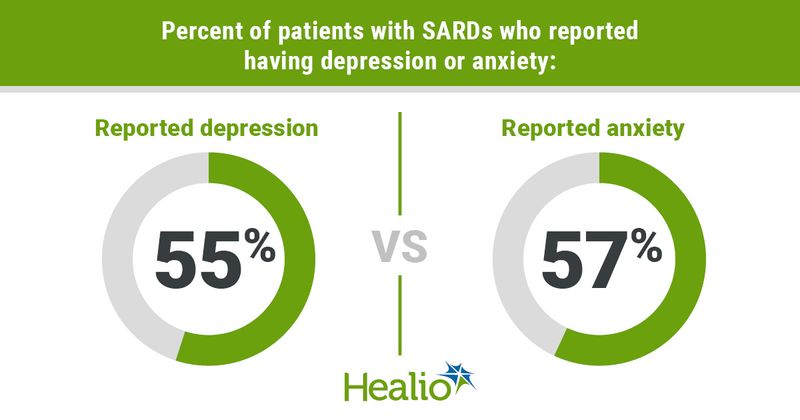Psychiatric symptom burden in SARDs higher, ‘more wide-ranging’ than previously recorded
Key takeaways:
- Barriers to reporting neuropsychiatric symptoms in patients with systemic autoimmune rheumatic diseases include limited knowledge and subjectivity.
- Most patients reported not being asked about their mental health by physicians.
The prevalence of neuropsychiatric symptoms in patients with systemic autoimmune rheumatic diseases is significantly “higher and more wide-ranging” than previously recognized, according to data published in Rheumatology.
“Although multiple studies have estimated the prevalence of a range of [neuropsychiatric (NP)] symptoms, particularly depression and anxiety, in a variety of [systemic autoimmune and rheumatic diseases (SARDs)], prevalence findings vary considerably,” Melanie Sloan, BSc (Hons), PGDip, of the University of Cambridge, in the United Kingdom, and colleagues wrote. “There are also gaps in the SARDs literature regarding a wider range of potential NP symptoms, such as psychiatric, neuroophthalmological, auditory-vestibular and peripheral nervous system (PNS) symptoms.

“Aside from systemic lupus erythematosus (SLE), where neuropsychiatric lupus (NPSLE) has been more widely researched, research on a range of NP symptoms in several SARDs is very limited, particularly undifferentiated connective tissue disease (UCTD) and polymyalgia rheumatica (PMR),” they added. “... In addition, it seems possible that studies have in general underestimated SARD NP symptom range and prevalence partly as the result of symptom exclusion.”
To better understand the connection between neuropsychiatric symptoms and SARDs, Sloan and colleagues collected and analyzed data from the INSPIRE project. According to the researchers, the INSPIRE project is a “series of inter-related mixed-method studies exploring various aspects of SARD NP symptoms identified by patient groups and clinicians as of key importance to investigate.” Patients were eligible to participate if they were aged 18 years or older and had a confirmed SARD. Meanwhile, rheumatologists, neurologists, psychiatrists and primary care physicians were eligible to participate by survey.
Control participants were invited by patients sending the survey link to their friends and acquaintances. Those aged older than 18 years and did not have “any serious incurable physical disease” were eligible to participate, the researchers wrote. To reduce the chances of interpretational differences, the Sloan and colleagues standardized lay definitions for use across the patient, clinician and control surveys.
The survey included 1,853 patients with systemic autoimmune rheumatic diseases, 289 clinicians and 463 control participants. A total of 113 interviews were analyzed. According to the researchers, all 30 investigated neuropsychiatric symptoms — including cognitive, sensorimotor and psychiatric manifestations — were more common in patients with SARDs vs. the control participants. The analysis also indicated that 55% of participating patients with SARDs had depression, while 57% had anxiety.
Participating physicians noted the difficulty in identifying these symptoms, the researchers wrote. Cited barriers to identification included limited tests and knowledge, subjectivity regarding symptom presence and under-documentation of symptoms. According to the researchers, 4% of physicians reported never or rarely asking patients about psychiatric symptoms, while 74% of patients reported never or rarely being asked about these symptoms.
“This study provides substantial evidence that the NP symptom burden is higher and more wide-ranging in the majority of SARDs than has previously been recognized, and that symptoms are often underreported and under-recorded,” Sloan and colleagues wrote. “More effective inter-disciplinary and patient-clinician collaboration is required to identify symptoms, and design criteria and research that is more reflective of the SARD NP symptoms experienced by patients.”

